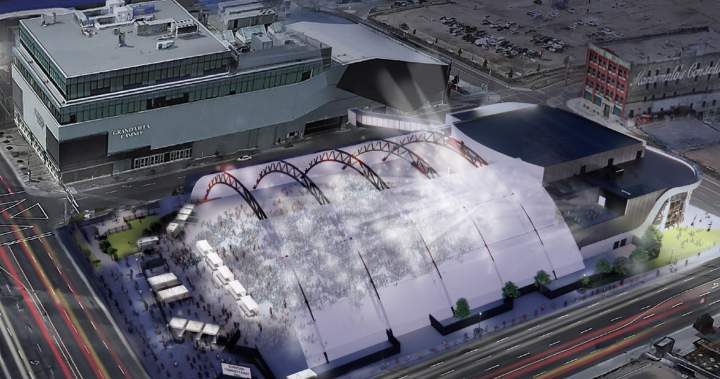The terms are now set to build a new event park and village at Ice District, as well as demolishing the old Coliseum.
The majority of Edmonton city council approved the $400 million master agreement plan after contentious deliberations on Monday. The vote came down 9 to 4.
This plan would bring redevelopment to the Ice District area by bringing an event venue that could hold 2,500 people indoors and 6,500 people outdoors.
There are also plans to build 2,500 units of affordable and rental housing, as well as green space.
The Alberta government will spend $183 million, the city of Edmonton will contribute $138 million, and Oilers Entertainment Group (OEG) will spend $87 million.
Renderings of redevelopment plans for Ice District that includes an event venue, green space and housing.
Credit: Oilers Entertainment Group
After lengthy discussions, some councillors questioned whether this deal was the right plan to approve.
Ward O’day’min Coun. Anne Stevenson expressed concerns that the list of options of what kind of events can be held at the venue wasn’t curtailed.
Get daily National news
Get the day’s top news, political, economic, and current affairs headlines, delivered to your inbox once a day.
I was really surprised by the contemplation about conferences and conventions at the event park. That was not on my radar throughout these conversations and I think its a direct threat to our city-owned convention centre,” Stevenson explained.
Ward Nakota Isga Coun. and mayoral candidate Andrew Knack was particularly fired up after learning the agreement between building housing and the event space was more vague than originally discussed.
“I’m frustrated because the whole point of this was to build housing. No, there’s no legal requirement to build housing,” Knack explained.
The timeline to review the deal was also a point of concern.
According to the city administration, negotiations with Oilers Entertainment Group (OEG) wrapped up last Tuesday.
City administration was recommending council to approve, because they wouldn’t be able to make any amendments by a Sept. 1 deadline set by the provincial government.
If a deal wasn’t finalized or approved by then, there was a risk of losing the deal entirely.
“Now, our gun’s to our head right now, saying, ‘No, don’t dare amend this agreement because if you amend it, we don’t have enough time to fix it,’” Knack said.
Meanwhile, Ward Dene Coun. Aaron Paquette said he was not surprised by any of the details in the report, and said it would have been a mistake if the city didn’t approve the deal.
“No one thought this was the ideal situation,” Paquette explained. “It’s very important to note if we had said no, we would lose out on $183 million from the province that would not come back.”
OEG has committed to building the first 354 units with $3-million of its contributions by 2028. The next 420 units would be built within the next five years, with the intention to complete the remainder by 2038.
“We are extremely proud of what’s been accomplished to date in ICE District with $3.2 billion in economic impact to the city, thousands of jobs created and developments that have not only revitalized a large part of downtown, but have significantly contributed to the Downtown CRL, funding a variety of public infrastructure projects—including this next phase of development,” Tim Shipton, EVP, OEG Sports & Entertainment, said in a statement.
“Housing will be developed in partnership with multiple organizations and include numerous housing typologies: purpose-built rentals, student, attainable, etc. There are many factors that will impact the timeline of development – financial, market, supply chain, economic, etc., but we are optimistic that we can begin development in short order,” the statement continued.
BILD Edmonton Metro CEO Kalan Anderson welcomes this deal.
She believes adding housing will attract more residents and boost retail.
“The first step of delivering over 350 units is excellent. That’s more units than Edmonton typically sees in a year downtown,” she said.
Anderson says partnerships between public and private groups are the best way to proceed with housing plans downtown.
“This has been an issue that’s been studied for years. What we need most downtown is people and to attract people more permanently, we need housing. If people are living downtown, we see more retail more activity,” she explained.
“The lack of cranes in the sky downtown isn’t because the development community doesn’t love the downtown, it’s because the projects weren’t able to lift off from a financial viability perspective,” she added.
However, the Canadian Taxpayers Federation is not impressed with funds going to a new event park.
Alberta Director Kris Sims criticizes both local and provincial governments for using public dollars to build facilities tied to private corporations.
“If the City of Edmonton wants to sit down with the province and talk about building housing, that’s a totally separate conversation. We should not have the NHL hooking call here,” Sims said.
“This is a really weird situation because Edmonton taxpayers already built a big shiny hockey rink for the Oilers to play in. It’s super weird that Edmonton city council seems to think that another big, shiny facility is going to solve the problems of downtown,” she added.
© 2025 Global News, a division of Corus Entertainment Inc.
Edmonton city council approves $400M deal to build event park, village at Ice District


